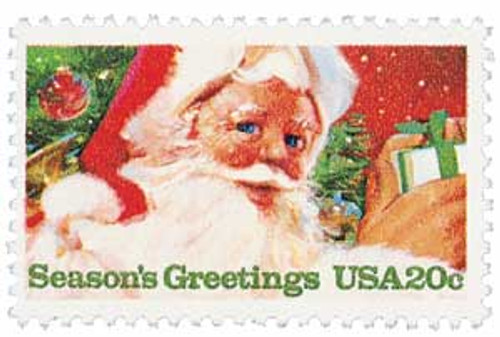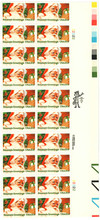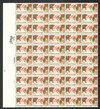
# 2064 - 1983 20c Contemporary Christmas: Santa Claus
U.S. #2064
1983 20¢ Santa Claus
Contemporary Christmas
- 19th Contemporary Christmas Issue
- 3rd Christmas stamp to picture Santa Claus
- 1st Christmas stamp to feature up-close view of Santa Claus
Stamp Category: Commemorative
Series: Contemporary Christmas
Value: 20¢, first-class rate
First Day of Issue: October 28, 1983
First Day City: Santa Claus, Indiana
Quantity Issued: 848,525,000
Printed by: Bureau of Engraving and Printing
Printing Method: Photogravure
Format: Panes of 50 in sheets of 200
Perforations: 11
Why the stamp was issued: To bring joy and whimsy to holiday mail.
About the stamp design: This was the first stamp design for John Berkey. His colorful and jolly image was the first to depict a close-up view of Santa on a US stamp. Santa had previously appeared on two stamps, one in 1972 and one in 1979. Berkey depicts his Santa holding a present, which is only partially pictured on the stamp, with a small portion of a Christmas tree visible behind him.
First Day City: The First Day ceremony for this stamp was held in Santa Claus, Indiana. The small town, which had a population of about 650 people at the time, was established in 1854. It was initially called Santa Fe, but when the town applied for a post office, they received a letter stating that there was already a Santa Fe, Indiana. The story of how they settled on Santa Claus has been lost to time, though many legends exist. Each year, the town receives thousands of letters from children around the world, each of which is answered by one of Santa’s Elves.
Unusual fact about this stamp: Imperforate error stamps have been found.
About the Contemporary Christmas series: The US issued its first Christmas stamp (picturing a wreath and candles) on November 1, 1962, and it was wildly popular. The Post Office printed 350 million stamps, the largest print run for a special stamp up to that time, but still the stamps quickly sold out. The Bureau of Engraving and Printing produced more to satisfy demand and the total number issued was over 860 million by the end of the year.
In 1966, the Post Office started issuing traditional themed Christmas stamps picturing the Madonna and Child and other religious icons. In 1969, they switched back to non-religious Christmas designs with a stamp picturing the painting Winter Sunday in Norway, Maine.
Finally, in 1970, the Post Office decided to permanently split Christmas stamps into two categories to satisfy everyone: Traditional and Contemporary. They issued a block of four stamps picturing Christmas toys along with a stamp picturing a classic painting of the Nativity. The decision to do both proved popular, and the Post Office has continued to issue stamps in both categories ever since.
History the stamp represents: Saint Nicholas of Myra died on December 6, 343. This date has long been celebrated as Saint Nicholas Day or the Fest of Saint Nicholas.
Saint Nicholas is believed to have been born on March 15, 270, in Patara, Roman Empire, near Myra, present-day Turkey, to wealthy parents. Many of the details of Nicholas’s life are based on older written stories and oral traditions. No writings from his lifetime survive, and most of the stories about his deeds were written centuries later.
According to tradition, Nicholas’s parents died in an epidemic when he was young and he moved in with his uncle – a bishop. Young Nicholas was deeply religious and took to heart the readings and teachings of Jesus. He began using his inheritance to anonymously assist the sick and needy. Although he left gifts down chimneys at night, a few found out he was behind the generosity. Nicholas begged for them to keep it a secret because he didn’t want the attention on himself. He became known as the protector of children and sailors before his death on December 6, 343.
Over the years, stories from Nicholas’s life spread and his feast day, December 6, was considered a lucky day to make large purchases or get married. In the Middle Ages, French nuns began leaving pouches of coins, food, and treats in the homes of the needy at night. When asked where these gifts came from, the nuns would simply say “it must have been Saint Nicholas.” This inspired the anonymous gift giving as well as all the carols.
By the Renaissance, Nicholas was the most popular saint in Europe, particularly in Holland. There he was known as Sinter Klaas, a shortened form of Sint Nokolaas, which was Dutch for Saint Nicholas. Soon it became a tradition for children to set their shoes by the hearth on the evening before his celebration. During the night, they believed he would fill them with small treats of nuts and fruit. When the Dutch settled in the New World, they brought their customs with them, including visits from Sinter Klaas. New York newspapers began reporting on these Dutch celebrations in 1773, making Saint Nicholas Day more widely known. Washington Irving further popularized Nicholas in 1809 when he referred to him as the patron Saint of New York in one of his books.
An 1822 poem written by Dr. Clement Clark Moore changed the image of Saint Nicholas in the US. The common title comes from the first line: “’Twas the night before Christmas.” Through this poem, written for his children, Moore introduced us to flying reindeer and a red-clad driver able to slide down chimneys effortlessly. Santa Claus, as he became popularly known, filled stockings, rather than shoes, with gifts. Artist Thomas Nast is often credited with creating the modern image of Santa Claus with his 1863 Harper’s Weekly illustration.
Stores began to include Santa in Christmas advertisements in the 1800s, with some offering children a chance to see Santa Claus in person. When the Salvation Army needed money to provide Christmas meals to needy families, they hired unemployed men to dress as Santa to collect donations.
Some other countries celebrate Saint Nicholas Day on December 5 or December 19. Many countries have different figures that bring children gifts. Germany has Kris Kringle, an angel that accompanies Saint Nicholas. Scandinavia celebrates the elf Jultomten, who brings gifts in a sleigh led by goats.
The English have Father Christmas and in France, Pere Noel leaves gifts in children’s shoes. In Russia, an elderly woman named Babushka leaves children gifts in the hopes that one is baby Jesus. According to Russian stories, she intentionally gave the three wise men incorrect directions to Bethlehem and gives these gifts to make up for her bad deed. In Italy a nice witch named La Befana rides a broomstick to deliver toys to children.
U.S. #2064
1983 20¢ Santa Claus
Contemporary Christmas
- 19th Contemporary Christmas Issue
- 3rd Christmas stamp to picture Santa Claus
- 1st Christmas stamp to feature up-close view of Santa Claus
Stamp Category: Commemorative
Series: Contemporary Christmas
Value: 20¢, first-class rate
First Day of Issue: October 28, 1983
First Day City: Santa Claus, Indiana
Quantity Issued: 848,525,000
Printed by: Bureau of Engraving and Printing
Printing Method: Photogravure
Format: Panes of 50 in sheets of 200
Perforations: 11
Why the stamp was issued: To bring joy and whimsy to holiday mail.
About the stamp design: This was the first stamp design for John Berkey. His colorful and jolly image was the first to depict a close-up view of Santa on a US stamp. Santa had previously appeared on two stamps, one in 1972 and one in 1979. Berkey depicts his Santa holding a present, which is only partially pictured on the stamp, with a small portion of a Christmas tree visible behind him.
First Day City: The First Day ceremony for this stamp was held in Santa Claus, Indiana. The small town, which had a population of about 650 people at the time, was established in 1854. It was initially called Santa Fe, but when the town applied for a post office, they received a letter stating that there was already a Santa Fe, Indiana. The story of how they settled on Santa Claus has been lost to time, though many legends exist. Each year, the town receives thousands of letters from children around the world, each of which is answered by one of Santa’s Elves.
Unusual fact about this stamp: Imperforate error stamps have been found.
About the Contemporary Christmas series: The US issued its first Christmas stamp (picturing a wreath and candles) on November 1, 1962, and it was wildly popular. The Post Office printed 350 million stamps, the largest print run for a special stamp up to that time, but still the stamps quickly sold out. The Bureau of Engraving and Printing produced more to satisfy demand and the total number issued was over 860 million by the end of the year.
In 1966, the Post Office started issuing traditional themed Christmas stamps picturing the Madonna and Child and other religious icons. In 1969, they switched back to non-religious Christmas designs with a stamp picturing the painting Winter Sunday in Norway, Maine.
Finally, in 1970, the Post Office decided to permanently split Christmas stamps into two categories to satisfy everyone: Traditional and Contemporary. They issued a block of four stamps picturing Christmas toys along with a stamp picturing a classic painting of the Nativity. The decision to do both proved popular, and the Post Office has continued to issue stamps in both categories ever since.
History the stamp represents: Saint Nicholas of Myra died on December 6, 343. This date has long been celebrated as Saint Nicholas Day or the Fest of Saint Nicholas.
Saint Nicholas is believed to have been born on March 15, 270, in Patara, Roman Empire, near Myra, present-day Turkey, to wealthy parents. Many of the details of Nicholas’s life are based on older written stories and oral traditions. No writings from his lifetime survive, and most of the stories about his deeds were written centuries later.
According to tradition, Nicholas’s parents died in an epidemic when he was young and he moved in with his uncle – a bishop. Young Nicholas was deeply religious and took to heart the readings and teachings of Jesus. He began using his inheritance to anonymously assist the sick and needy. Although he left gifts down chimneys at night, a few found out he was behind the generosity. Nicholas begged for them to keep it a secret because he didn’t want the attention on himself. He became known as the protector of children and sailors before his death on December 6, 343.
Over the years, stories from Nicholas’s life spread and his feast day, December 6, was considered a lucky day to make large purchases or get married. In the Middle Ages, French nuns began leaving pouches of coins, food, and treats in the homes of the needy at night. When asked where these gifts came from, the nuns would simply say “it must have been Saint Nicholas.” This inspired the anonymous gift giving as well as all the carols.
By the Renaissance, Nicholas was the most popular saint in Europe, particularly in Holland. There he was known as Sinter Klaas, a shortened form of Sint Nokolaas, which was Dutch for Saint Nicholas. Soon it became a tradition for children to set their shoes by the hearth on the evening before his celebration. During the night, they believed he would fill them with small treats of nuts and fruit. When the Dutch settled in the New World, they brought their customs with them, including visits from Sinter Klaas. New York newspapers began reporting on these Dutch celebrations in 1773, making Saint Nicholas Day more widely known. Washington Irving further popularized Nicholas in 1809 when he referred to him as the patron Saint of New York in one of his books.
An 1822 poem written by Dr. Clement Clark Moore changed the image of Saint Nicholas in the US. The common title comes from the first line: “’Twas the night before Christmas.” Through this poem, written for his children, Moore introduced us to flying reindeer and a red-clad driver able to slide down chimneys effortlessly. Santa Claus, as he became popularly known, filled stockings, rather than shoes, with gifts. Artist Thomas Nast is often credited with creating the modern image of Santa Claus with his 1863 Harper’s Weekly illustration.
Stores began to include Santa in Christmas advertisements in the 1800s, with some offering children a chance to see Santa Claus in person. When the Salvation Army needed money to provide Christmas meals to needy families, they hired unemployed men to dress as Santa to collect donations.
Some other countries celebrate Saint Nicholas Day on December 5 or December 19. Many countries have different figures that bring children gifts. Germany has Kris Kringle, an angel that accompanies Saint Nicholas. Scandinavia celebrates the elf Jultomten, who brings gifts in a sleigh led by goats.
The English have Father Christmas and in France, Pere Noel leaves gifts in children’s shoes. In Russia, an elderly woman named Babushka leaves children gifts in the hopes that one is baby Jesus. According to Russian stories, she intentionally gave the three wise men incorrect directions to Bethlehem and gives these gifts to make up for her bad deed. In Italy a nice witch named La Befana rides a broomstick to deliver toys to children.










